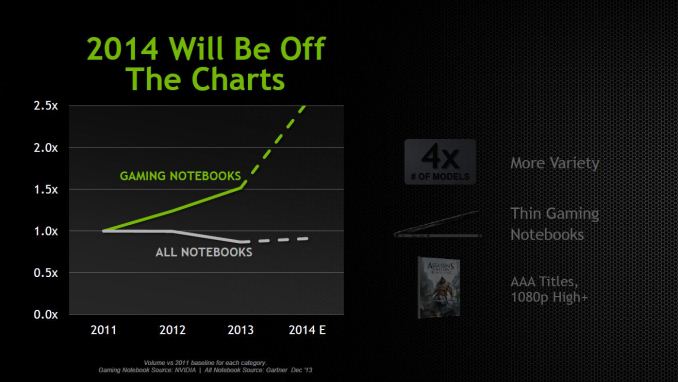NVIDIA’s GeForce 800M Lineup for Laptops and Battery Boost
by Jarred Walton on March 12, 2014 12:00 PM ESTClosing Thoughts
Overall, NVIDIA’s mobile GPU solutions continue to be the de facto standard bearer for gaming laptops. AMD’s upcoming Kaveri APUs will almost certainly do well in the budget sector, but users that want more performance – from both the CPU as well as the GPU – will likely continue to go with NVIDIA Optimus solutions, and if you’re the type of gamer that wants to be able to run at least 1080p with high quality settings, you’ll need at least a GTX class GPU to get there. The good news is that you should have plenty of choices in the coming months, and not only are we seeing faster GPUs but many laptops are starting to come out with high quality 3K and 4K displays.
Speaking of which, I also want to note that anyone that thinks “gaming laptops” are a joke either needs to temper their requirements or else give some of the latest offerings a shot. While it’s not possible to simply run all games at 1080p (or QHD+) with maxed out settings without a beefy GPU, even the GT 750M GDDR5 is able to deliver a good gaming experience for most titles at 900p High/1080p Medium settings. The GTX 850M should be quite a bit faster (~60%) than the GT 750M, and we should see it in notebooks that may cost as little as $1000. It’s no surprise then that NVIDIA thinks 2014 gaming notebook sales will be “off the charts”.
As is often the case, we haven’t been sampled any notebooks prior to the launch of the latest 800M series, but we should get some in the near future. We’re looking forward to Maxwell parts in particular, though for now it appears we’ll have to wait a bit for the high-end Maxwell SKUs to arrive (just like on the desktop). It will also be interesting to see how the GTX 860M Kepler and Maxwell variants compare in terms of performance, power, and battery life; I suspect the Maxwell parts will be the ones to get for optimal performance and power requirements, but we shall see.
The latest updates from NVIDIA aren't revolutionary in most areas, but Battery Boost at least could open the doors for more people to consider gaming notebooks. There's always the question of long-term reliability and upgradeability, which are inherently easier to deal with on a desktop, but with a modern laptop I can quite easily connect to an external display, keyboard, mouse, and speakers and never realize that I'm not using a desktop – until I launch a game, at least. What's even better is that when it comes time to take a trip, if all your data already resides on a laptop there's nothing to worry about; you just pack up and leave. That convenience factor alone is enough for many to have made the switch to using a laptop full-time, and I'm not far off from joining them. 2014 may prove to be the year where I finally make the switch.
Last but not least, for those that like the unfiltered NVIDIA slides, you can find those in the gallery below.



_thumb.jpg)
_thumb.jpg)
_thumb.jpg)
_thumb.jpg)
_thumb.jpg)
_thumb.jpg)








91 Comments
View All Comments
willis936 - Sunday, March 16, 2014 - link
Good grief OEMs aren't listing which 860m is in which laptop SKU which leaves me believing thatbtheyre actually mixing maxwell and kepler bins. That pisses me off greatly because one chip has a higher value than the other and they're leaving it literally up to luck. If I get a laptop this summer I will return it if I get a Kepler chip without hesitation and try a different site to buy from.Also the quoted max of 2GB for the 860m is interesting because gigabytes "p34g v2" product page shows the 860m with 4GB DDR5.